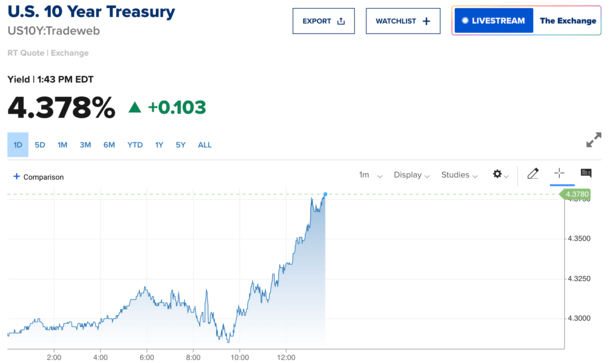A day after the Fed held its key policy rate steady, 10-year bond yields are up double-digits.
And that will result in higher mortgage rates for consumers, all else equal, though the driver appears to be an unrelated trade deal with the United Kingdom.
The bellwether bond was up more than 10 basis points to nearly 4.38 on the day after appearing to spike out of nowhere.
The only real reason would be the U.K.-U.S. trade deal, which coincided with a stock market rally.
In short, investors left bonds behind and piled into stocks, which resulted in higher bond yields (and mortgage rates).
Is This a Sign of Things to Come?

The newly-announced trade deal with the U.K. was somewhat scant on details, though the 10% tariff on imported goods will remain in place.
And vehicles from the U.K. will see tariffs reduced from 27.5% to 10%, while tariffs on steel and aluminum are eliminated.
Of course, a trade deal with one of our closest allies isn’t necessarily the big news we’ve been waiting for.
Ultimately, it’s China and has always been China. This is kind of a sideshow and not necessarily illustrative of what will transpire there.
Investors seemed to cheer it anyway, a day after the Fed said due to the global trade war, “risks of higher unemployment and higher inflation have risen.”
This would mark some normalcy for markets, with good economic news typically resulting in stock market rallies and a flight away from the safety of bonds.
In other words, a risk-on event where investors feel more comfortable piling back into stocks and other higher-yielding investments.
That means bonds lose their luster and their price is driven down, which correspondingly results in higher bond yields.
When long-term bond yields go up, mortgage rates go up.
Will Home Buyers Be Hurt by Trade Deals?
It’s still too early to know if this is meaningful, or just a trade for the day that will reverse in short order.
And as noted, this deal with the U.K. is a not a deal with China, so if and when talks get underway there, it could look a lot different.
But if more trade deals come along, investors might look at this as getting back to basics. To consider economic data instead of worrying about tariffs.
If that’s the case, and the economic data continues to come in positive, that could keep pressure on 30-year fixed mortgage rates.
Remember, strong economic growth is generally bad for mortgage rates, while weakness can lead to lower rates.
Initial jobless claims got released this morning as well and came in below forecast, “with no signs of recession or layoffs.”
Taken together, this is the type of stuff that would keep the Fed from cutting rates anytime soon.
That too would keep upward pressure on mortgage rates. And if you look at probabilities for the fed funds rate from CME, cuts keep getting pushed further out.
Recently, four fed rate cuts were expected in 2025 alone, now it’s three, and soon it could be two.
This is all based on the strength of the economy, which arguably is stronger with a more subdued or weakened trade war.
Watch Out for Higher Mortgage Rates Either Way
The takeaway for now, given how fluid this is, is to expect higher mortgage rates in just about any scenario.
It seems trade deals are being cheered by investors, while uncertainty regarding trade deals isn’t necessarily benefiting bonds.
Typically, there’s a flight to safety in bonds when investors are nervous, but lately we’ve seen stocks and bonds fall together.
Really, the only scenario where mortgage rates appear to benefit is from actual soft economic data.
There’s still a lot of pent up consumer sentiment that alludes to economic weakness, but until we actually see it in the hard data, mortgage rates might have a tough time moving lower.
In other words, expect most narratives to lead to higher mortgage rates, or at least not lower ones for the foreseeable future.
That doesn’t mean they don’t eventually come down later this year, but right now the relief seems to be getting pushed further and further out, possibly into 2026.
I had expected lower rates beginning in the third quarter, which is still possible, but it might come in the fourth quarter or later if the economy holds up better than anticipated.
Read on: 10 Simple Ways You Can Save Money on Your Next Mortgage

